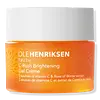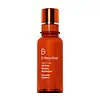What's inside
What's inside
 Key Ingredients
Key Ingredients

 Benefits
Benefits

 Concerns
Concerns

 Ingredients Side-by-side
Ingredients Side-by-side

Water
Skin ConditioningGlycerin
HumectantDicaprylyl Carbonate
EmollientPropanediol
SolventCaprylic/Capric Triglyceride
Masking3-O-Ethyl Ascorbic Acid
Skin ConditioningGlycereth-26
HumectantAmmonium Acryloyldimethyltaurate/Beheneth-25 Methacrylate Crosspolymer
Emulsion StabilisingHydrolyzed Jojoba Esters
Skin ConditioningCetearyl Alcohol
EmollientPolyacrylate Crosspolymer-6
Emulsion StabilisingHydroxyacetophenone
AntioxidantPanthenol
Skin ConditioningPolyglyceryl-3 Methylglucose Distearate
EmulsifyingTetrahexyldecyl Ascorbate
AntioxidantLinoleic Acid
CleansingCitric Acid
BufferingPhenoxyethanol
PreservativeParfum
MaskingPentaerythrityl Tetra-Di-T-Butyl Hydroxyhydrocinnamate
AntioxidantXanthan Gum
EmulsifyingCetearyl Glucoside
EmulsifyingLinolenic Acid
CleansingCitrus Aurantium Dulcis Fruit Extract
MaskingCitrus Limon Fruit Extract
MaskingHippophae Rhamnoides Extract
MaskingLycium Barbarum Fruit Extract
AstringentRosa Canina Fruit Extract
AstringentEthylhexylglycerin
Skin ConditioningLeuconostoc/Radish Root Ferment Filtrate
AntimicrobialSodium Citrate
BufferingCamellia Japonica Flower Extract
EmollientAroma
Sodium Hyaluronate
HumectantSodium Polyacrylate
AbsorbentSodium Phytate
Hyaluronic Acid
HumectantCollagen
MoisturisingAscorbic Acid
AntioxidantTocopherol
AntioxidantCI 15985
Cosmetic ColorantCI 19140
Cosmetic ColorantCitral
PerfumingLimonene
PerfumingLinalool
PerfumingBenzyl Alcohol
PerfumingWater, Glycerin, Dicaprylyl Carbonate, Propanediol, Caprylic/Capric Triglyceride, 3-O-Ethyl Ascorbic Acid, Glycereth-26, Ammonium Acryloyldimethyltaurate/Beheneth-25 Methacrylate Crosspolymer, Hydrolyzed Jojoba Esters, Cetearyl Alcohol, Polyacrylate Crosspolymer-6, Hydroxyacetophenone, Panthenol, Polyglyceryl-3 Methylglucose Distearate, Tetrahexyldecyl Ascorbate, Linoleic Acid, Citric Acid, Phenoxyethanol, Parfum, Pentaerythrityl Tetra-Di-T-Butyl Hydroxyhydrocinnamate, Xanthan Gum, Cetearyl Glucoside, Linolenic Acid, Citrus Aurantium Dulcis Fruit Extract, Citrus Limon Fruit Extract, Hippophae Rhamnoides Extract, Lycium Barbarum Fruit Extract, Rosa Canina Fruit Extract, Ethylhexylglycerin, Leuconostoc/Radish Root Ferment Filtrate, Sodium Citrate, Camellia Japonica Flower Extract, Aroma, Sodium Hyaluronate, Sodium Polyacrylate, Sodium Phytate, Hyaluronic Acid, Collagen, Ascorbic Acid, Tocopherol, CI 15985, CI 19140, Citral, Limonene, Linalool, Benzyl Alcohol
Water
Skin ConditioningSqualane
EmollientGlycerin
Humectant3-O-Ethyl Ascorbic Acid
Skin ConditioningTetrahexyldecyl Ascorbate
AntioxidantAscorbic Acid
AntioxidantLactic Acid
BufferingSilybum Marianum Fruit Extract
Skin ConditioningNiacinamide
SmoothingCentella Asiatica Extract
CleansingCeramide Ng
Skin ConditioningSuperoxide Dismutase
AntioxidantQuercetin
AntioxidantPhospholipids
Skin ConditioningSodium Hyaluronate
HumectantHydrolyzed Sodium Hyaluronate
Skin ConditioningSodium Carboxymethyl Beta-Glucan
CleansingInonotus Obliquus Extract
Skin ConditioningSaccharide Isomerate
HumectantFerulic Acid
AntimicrobialUbiquinone
AntioxidantSoy Isoflavones
Skin ConditioningAloe Barbadensis Leaf Juice
Skin ConditioningPhytosphingosine
Skin ConditioningLeuconostoc/Radish Root Ferment Filtrate
AntimicrobialMethyl Gluceth-20
HumectantPropylene Glycol
HumectantSodium PCA
HumectantMyristyl Myristate
EmollientButylene Glycol
HumectantPolyglyceryl-10 Laurate
Skin ConditioningPentylene Glycol
Skin ConditioningCaprylyl Glycol
EmollientAdenosine
Skin ConditioningCarbomer
Emulsion StabilisingCetearyl Olivate
Polyacrylate Crosspolymer-6
Emulsion StabilisingLauryl Laurate
Skin ConditioningSodium Hydroxide
BufferingPotassium Hydroxide
BufferingSodium Glycolate
BufferingC13-15 Alkane
SolventSorbitan Olivate
EmulsifyingPhytic Acid
Citric Acid
BufferingSodium Citrate
BufferingTetrasodium Glutamate Diacetate
Pentasodium Pentetate
Camellia Sinensis Leaf Extract
AntimicrobialCucumis Sativus Fruit Extract
EmollientTriethyl Citrate
MaskingLavandula Angustifolia Flower/Leaf/Stem Extract
MaskingElettaria Cardamomum Seed Extract
PerfumingPyrus Malus Fruit Extract
Skin ConditioningRubus Idaeus Fruit Extract
AstringentCananga Odorata Flower Extract
PerfumingCitrus Aurantium Bergamia Fruit Extract
Skin ConditioningCitrus Aurantium Amara Flower Extract
RefreshingCoffea Arabica Seed Extract
MaskingCucumis Melo Fruit Extract
Skin ConditioningCupressus Sempervirens Leaf/Stem Extract
Skin ConditioningFucus Vesiculosus Extract
EmollientJasminum Officinale Flower Extract
MaskingRose Extract
Skin ConditioningRosmarinus Officinalis Leaf Extract
AntimicrobialSalvia Officinalis Leaf Extract
CleansingSantalum Album Wood Extract
PerfumingPhenoxyethanol
PreservativeSorbic Acid
PreservativePotassium Sorbate
PreservativeWater, Squalane, Glycerin, 3-O-Ethyl Ascorbic Acid, Tetrahexyldecyl Ascorbate, Ascorbic Acid, Lactic Acid, Silybum Marianum Fruit Extract, Niacinamide, Centella Asiatica Extract, Ceramide Ng, Superoxide Dismutase, Quercetin, Phospholipids, Sodium Hyaluronate, Hydrolyzed Sodium Hyaluronate, Sodium Carboxymethyl Beta-Glucan, Inonotus Obliquus Extract, Saccharide Isomerate, Ferulic Acid, Ubiquinone, Soy Isoflavones, Aloe Barbadensis Leaf Juice, Phytosphingosine, Leuconostoc/Radish Root Ferment Filtrate, Methyl Gluceth-20, Propylene Glycol, Sodium PCA, Myristyl Myristate, Butylene Glycol, Polyglyceryl-10 Laurate, Pentylene Glycol, Caprylyl Glycol, Adenosine, Carbomer, Cetearyl Olivate, Polyacrylate Crosspolymer-6, Lauryl Laurate, Sodium Hydroxide, Potassium Hydroxide, Sodium Glycolate, C13-15 Alkane, Sorbitan Olivate, Phytic Acid, Citric Acid, Sodium Citrate, Tetrasodium Glutamate Diacetate, Pentasodium Pentetate, Camellia Sinensis Leaf Extract, Cucumis Sativus Fruit Extract, Triethyl Citrate, Lavandula Angustifolia Flower/Leaf/Stem Extract, Elettaria Cardamomum Seed Extract, Pyrus Malus Fruit Extract, Rubus Idaeus Fruit Extract, Cananga Odorata Flower Extract, Citrus Aurantium Bergamia Fruit Extract, Citrus Aurantium Amara Flower Extract, Coffea Arabica Seed Extract, Cucumis Melo Fruit Extract, Cupressus Sempervirens Leaf/Stem Extract, Fucus Vesiculosus Extract, Jasminum Officinale Flower Extract, Rose Extract, Rosmarinus Officinalis Leaf Extract, Salvia Officinalis Leaf Extract, Santalum Album Wood Extract, Phenoxyethanol, Sorbic Acid, Potassium Sorbate
Ingredients Explained
These ingredients are found in both products.
Ingredients higher up in an ingredient list are typically present in a larger amount.
You might know this ingredient as Ethyl Ascorbic Acid, a more stable version of ascorbic acid.
Like other types of vitamin C, this ingredient has many benefits including reducing wrinkles, skin soothing, dark spot fading, and fighting against free radicals.
3-O-Ethyl Ascorbic Acid interferes with the process of skin darkening, helping to reduce hyperpigmentation. It also encourages the skin to produce more collagen.
Once applied, 3-O-Ethyl Ascorbic Acid is converted to Vitamin C deeper in the skin's layers. This process is slow but makes this ingredient more tolerable for skin.
The optimum pH range for this ingredient is 4 - 5.5
Learn more about 3-O-Ethyl Ascorbic AcidAscorbic Acid is is pure Vitamin C. This form makes up the largest amount of vitamin C found naturally in our skin.
Not only is vitamin C great for your overall health and immune system, it also has plenty of benefits on your skin.
Vitamin C is best used for brightening skin. It improves dark spots, acne scars, and hyperpigmentation. This is because it blocks the process of skin darkening when exposed to UV.
Remember: Vitamin C should not replace sunscreen!
Your skin uses vitamin C to build collagen. Collagen is one key component in having a strong skin barrier and plump skin. Vitamin C also plays a role in regulating collagen, thus making it effective in improving wrinkles and fine lines.
Ascorbic acid shows potent antioxidant activity. As an antioxidant, it helps fight free-radicals. Free-radicals are molecules that may damage your skin cells. These antioxidants also protect skin against UV damage.
The best formulations include Vitamin E and/or ferulic acid. These two ingredients help stabilize and provide a boost in the benefits of ascorbic acid. This is because ascorbic acid becomes unstable when exposed to UV and air. In fact, you can tell your ascorbic acid has oxidized when it turns an orange-yellow color.
Ascorbic acid is generally compatible with other ingredients. However, using ascorbic acid with other active ingredients might cause irritation. Two ingredients: copper ions and benzoyl peroxide, will inactivate ascorbic acid completely.
Read more about other types of Vitamin C:
Foods rich with vitamin C include oranges, strawberries, broccoli, bell peppers, and more. When consuming Vitamin C, your skin receives a portion of the nutrients.
Learn more about Ascorbic AcidCitric Acid is an alpha hydroxy acid (AHA) naturally found in citrus fruits like oranges, lemons, and limes.
Like other AHAs, citric acid can exfoliate skin by breaking down the bonds that hold dead skin cells together. This helps reveal smoother and brighter skin underneath.
However, this exfoliating effect only happens at high concentrations (20%) which can be hard to find in cosmetic products.
Due to this, citric acid is usually included in small amounts as a pH adjuster. This helps keep products slightly more acidic and compatible with skin's natural pH.
In skincare formulas, citric acid can:
While it can provide some skin benefits, research shows lactic acid and glycolic acid are generally more effective and less irritating exfoliants.
Most citric acid used in skincare today is made by fermenting sugars (usually from molasses). This synthetic version is identical to the natural citrus form but easier to stabilize and use in formulations.
Read more about some other popular AHA's here:
Learn more about Citric AcidGlycerin is already naturally found in your skin. It helps moisturize and protect your skin.
A study from 2016 found glycerin to be more effective as a humectant than AHAs and hyaluronic acid.
As a humectant, it helps the skin stay hydrated by pulling moisture to your skin. The low molecular weight of glycerin allows it to pull moisture into the deeper layers of your skin.
Hydrated skin improves your skin barrier; Your skin barrier helps protect against irritants and bacteria.
Glycerin has also been found to have antimicrobial and antiviral properties. Due to these properties, glycerin is often used in wound and burn treatments.
In cosmetics, glycerin is usually derived from plants such as soybean or palm. However, it can also be sourced from animals, such as tallow or animal fat.
This ingredient is organic, colorless, odorless, and non-toxic.
Glycerin is the name for this ingredient in American English. British English uses Glycerol/Glycerine.
Learn more about GlycerinLeuconostoc/Radish Root Ferment Filtrate is a natural preservative. It comes from fermenting radish roots with a bacteria called leuconostoc.
Leuconostoc comes from lactic acid.
This ingredient has antimicrobial properties and helps prevent the growth of bacteria in a product.
Leuconostoc is used to make the traditional Korean side-dish, kimchi. It is also used to make sourdough bread (both incredibly yummy foods).
Learn more about Leuconostoc/Radish Root Ferment FiltratePhenoxyethanol is a preservative that has germicide, antimicrobial, and aromatic properties. Studies show that phenoxyethanol can prevent microbial growth. By itself, it has a scent that is similar to that of a rose.
It's often used in formulations along with Caprylyl Glycol to preserve the shelf life of products.
Polyacrylate Crosspolymer-6 is a texture enhancer and pH adjuster.
It is be used to thicken water-based products and create a gel-texture with a velvet feel.
One manufacturer claims this ingredient to have a pH range of 2-8 and to be biodegradable.
Learn more about Polyacrylate Crosspolymer-6Sodium Citrate is the sodium salts of citric acid. In skincare, it is used to alter pH levels and acts as a preservative.
Its main functions are to maintain the pH of a product and neutralize metal ions.
The acidity of our skin is maintained by our glands and skin biome; normal pH level of skin is slightly acidic (~4.75-5.5).
Being slightly acidic allows our skin to create an "acid mantle". This acid mantle is a thin barrier that protects our skin from bacteria and contaminants.
Learn more about Sodium CitrateSodium Hyaluronate is hyaluronic acid's salt form. It is commonly derived from the sodium salt of hyaluronic acid.
Like hyaluronic acid, it is great at holding water and acts as a humectant. This makes it a great skin hydrating ingredient.
Sodium Hyaluronate is naturally occurring in our bodies and is mostly found in eye fluid and joints.
These are some other common types of Hyaluronic Acid:
Learn more about Sodium HyaluronateTetrahexyldecyl Ascorbate (THD) is a stable and oil-soluble form of Vitamin C.
THD is special in that it has the ability to travel deeper into skin than traditional ascorbic acid while maintaining the same skin benefits (double win!).
Because it’s oil-soluble, THD dives deep into your skin’s fatty layers (think ceramides and cholesterol) to fight off the kind of free radicals that mess with your skin barrier. This makes it a great pair with water-based vitamin C (ascorbic acid) that mainly works on the surface.
Even at just 0.1%, THD is already showing great antioxidant activity. When used up to 2%, it helps keep your skin happy and calm, especially when it’s stressed from pollution or sun.
Want to fade dark spots or tackle hyperpigmentation? You’ll want 5% or more. Pairing it with brightening buddies like niacinamide or licorice root gives even better results. One study even used 30% THD with other brighteners and saw real results on stubborn discoloration, even in melasma-prone skin.
A note on THD: It’s has a slightly silky, oily texture and usually shows up colorless or pale yellow (though the exact shade can vary by supplier).
While you can sneak it into water-based formulas, it really shines when paired with silicones or oils, which help your skin soak it up better.
THD is pretty stable, but it’s still vulnerable to degradation like ascorbic acid. Too much light or heat (above 113°F / 45°C) can break it down over time. Go for dark and opaque packaging that keeps it safe and shady!
Read more about other types of Vitamin C:
Learn more about Tetrahexyldecyl AscorbateWater. It's the most common cosmetic ingredient of all. You'll usually see it at the top of ingredient lists, meaning that it makes up the largest part of the product.
So why is it so popular? Water most often acts as a solvent - this means that it helps dissolve other ingredients into the formulation.
You'll also recognize water as that liquid we all need to stay alive. If you see this, drink a glass of water. Stay hydrated!
Learn more about Water